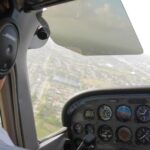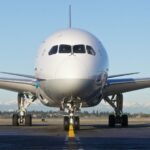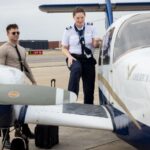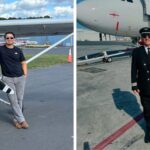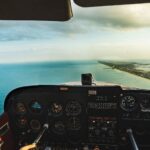Pilot’s Digest: Tell us a little about yourself.
Robert Orozco: After high school I joined the Air Force at 17 years old with my parent’s consent. I met my very supportive wife at my first duty station. We started our small family a few years later.
During that time, I decided to transfer to the USAF Reserves and cross trained into Vertical Construction (structures). I followed the construction path for a few years and was activated stateside a few times while I was a reservist. Eventually, I realized with a declining housing market that I had a relatively low earning potential and undeterminable job stability if I were to purse that as a long-term career. I decided to go back into technologies and focused on completing professional certifications, specifically networking certifications and I was quite happy for a long period. Currently, I am employed as a Senior Network Engineer, aspiring to become a professional pilot.
PD: How did you get into flying?
RO: This is going to seem a bit cliché. However, the movie “Top Gun” had come out in 1986; I think I saw it in 1988 for the first time. I was enamored with the concept of flight ever since the first time I saw that movie. That was further reinforced by plenty of other aviation-related movies throughout my childhood. Jimmy Stewart is probably my favorite actor/aviator.
For my 14th birthday my father’s present to me was a discovery flight at KMYF. I knew at that point I needed to fly in some capacity. It seemed rather difficult prior to that experience; afterwards it seemed somewhat achievable. The magnet program I subsequently attended was one of seven in the nation that offered Aeronautics as an elective. That really drove it home for me. I was able to amass 60 free dual hours from grades 10 through 12 as an elective.
After high school I took a break for a few years. I eventually returned to aviation and obtained my PPL at the Beale AFB Aero Club when I was 24 while working as an activated reservist.
PD: Why did you take 10 years off from flying?
RO: In a word, “life.” A high paying career is a bit of a double-edged sword. It awards an individual a hefty salary but deprives that person of certain liberties. One such liberty is time. I had prioritized chasing higher paying jobs to provide for my family and what most people would consider “toys” for the weekends I wasn’t working. I moved to Houston about 10 years ago for its attractive cost of living and surging employment trends. Flying was a luxury I couldn’t afford when I first moved here. The student loans I had taken out were starting to come due as I had quit college because of moving to Houston and having to establish myself within my chosen career path at the time.
It’s a decision I regret. I didn’t prioritize my goals appropriately. I rationalize not having the money or time back then. However, I know plenty of people that had twice as much going on and half as much income who were/are able to make it work. In retrospect, I could have done it, but I wasn’t willing to make the needed sacrifices.
PD: Tell us how you went about choosing a flight school.
RO: I started with the internet. I called a few schools, five if I recall correctly. Things that were important to me included proximity to my current employer and home, flexibility to accommodate a training schedule that would be quite erratic with my current job, standardization of training equipment to include planes and syllabus, and last but not least was the people. I also asked a few pilots at work where they had trained and if they could make any recommendations.
PD: What made you choose American Flyers?
RO: I called American Flyers and initially spoke with Brian. We did a basic logbook review over the phone. He asked about my ultimate goals and timeline associated with them. He provided me a rough estimate in email and directed me to the local school at David Wayne Hooks where I would meet with Kenneth and Mason. I went to the school to do a formal review of my logbook and further discuss my intentions. To this point in my search of a school, American Flyers was the most personable and seemed to really have it together. I didn’t feel as though I was getting the sales pitch.
I discussed with Kenneth the concept of completing my instrument rating on an aggressive timeline and the fact that I hadn’t flown in 10 years. I had scheduled some vacation time from my employer to focus my efforts on flight training for 14 consecutive days. Kenneth set expectations for me and assured me their commitment would match my own level of dedication. Upon leaving that day, I had the instrument flight instruction manual in hand and was tentatively scheduled for the Instrument ground school for instrument written prep that was coming up in a few weeks.
I felt this was the right school for me. They would accommodate my scheduling; they developed a plan of attack with me; they seemed dedicated to the mission. The instructors I met were cordial and seemed genuine. There was absolutely zero pressure to sign on with American Flyers. I felt I was in the company of honest people who had the ability to train me and wouldn’t deceive me.
PD: How much outside studying did you have to put in during your time with AF?
RO: I was given some of the course material ahead of attending the instrument written prep course. I was able to get about 20 hours of actual studying in before attending the written course. After completion of the course, I tested and passed that Sunday afternoon. I think that was in part due to the comprehensive content and delivery of the material itself.
During the planning with Kenneth, it was conveyed to me that getting the written completed prior to flight training, although not necessary, would be critical to successfully attaining my instrument rating in such a short period of time. He couldn’t have been more correct. I didn’t have any “extra” time during flight training to study for the written had it not already been completed.
During the flight training phase I was putting in about 18-hours a day; some days may have been a bit longer. I was on for sim, ground and flight almost every day. I would train at school and self-study every night. Suffice it to say, it was as grueling as Kenneth had promised/warned me it would be. Prior to starting flight training, Kenneth advised me to come in and do some solo sim. I still needed to pass my flight review before I could start logging time. I put in 12 hours of solo sim the weekend prior to beginning flight training.
PD: What is your most memorable moment at American Flyers?
RO: I’ve had a couple and will continue to have many more memorable moments as I continue to train with American Flyers. One that stands out is my cross country to Addison. It was a little over five and a half hours long. The flight served two purposes. One was to accomplish my 250nm cross country. The other was to drop off one of the instructors to ferry a plane back to KDWH.
I remember thinking to myself I was legitimate at that point. I do realize I’m quite a way from being a professional pilot at the moment, but this was my first “mission-oriented” flight. We had a purpose for flying other than purely for training or sight-seeing.
PD: Looking back, what advice would you give someone interested in starting pilot training?
RO: Don’t allow yourself to make excuses. Do it! Make the time, put the effort in, make any sacrifices that you reasonably can, it is attainable. If it’s the difference between food on your family’s table or paying for a few hours of time, well, perhaps that’s the only acceptable excuse.
PD: What’s next for you?
RO: I’m currently enrolled for my commercial rating at American Flyers at Hooks. I’m working full-time still and hope to take a few short periods of vacation in a few months to focus my efforts once again solely on my aviation goals. I plan to continue with American Flyers after completion of the commercial rating to work on CFI, CFI-I and MEL. My goal is to complete those ratings and subsequently apply for an instructor position with American Flyers and other schools by mid-summer of 2019. I’m hopeful that American Flyers would have openings at that time and that I have what it takes.






